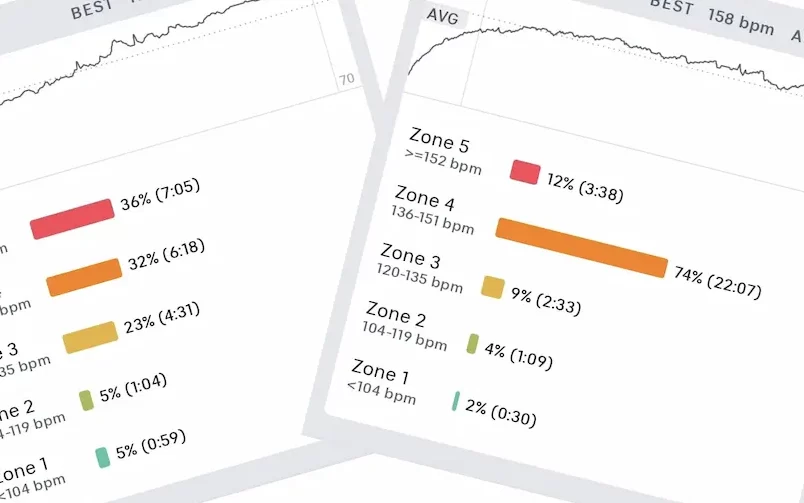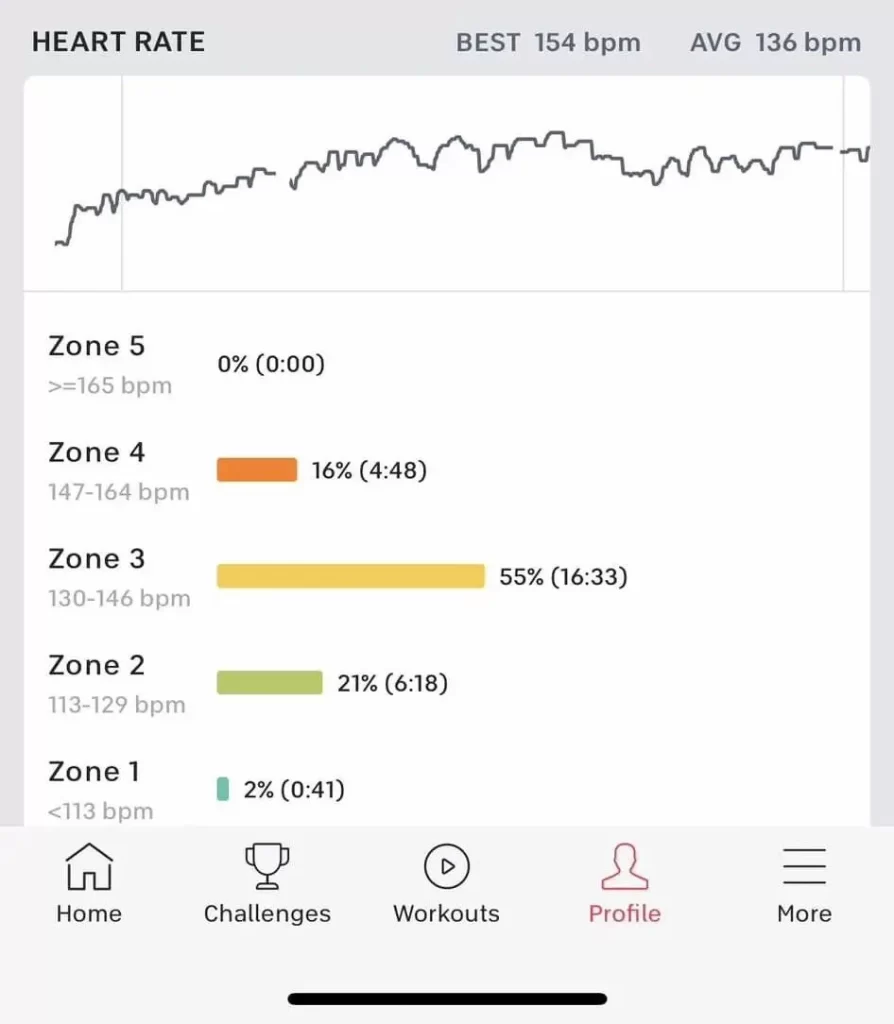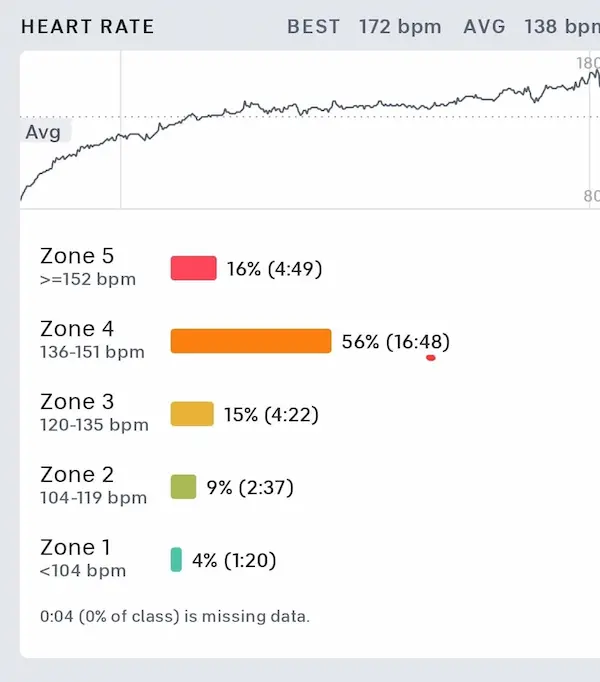One of the things that allowed me to lose over 25 lbs in 3 months was using Peloton heart rate zones to monitor my workout intensity.
In this article, you will learn what are the peloton heart rate zones and some of the cool ways to use them in your daily exercise routine.

Overview
In a nutshell.
- The peloton heart rate zones serve as a guide to determining the intensity of my workouts.
- It helps me to know when to increase or decrease the intensity, based on my current fitness goals.
- I also used it to design my weekly workout plan, monitor my progress, and adjust my recovery days.
What are Peloton heart rate zones?
Peloton heart rate zones (in short HR zones) provide me with real-time feedback and allow me to monitor the intensity level of the classes.
- You know you’re at the peloton heart rate zone 2 when your breathing rate is high, however, you still can manage to maintain a conversation.
- The peloton heart rate zone 3 (also called aerobic zone) is the intensity level where the body reaches 70-80% maximum heart rate. This workout intensity can be usually maintained for multiple hours, depending on your fitness level.
- The peloton heart rate zone 4 (which is also called the Threshold zone) refers to workout intensity where you can maintain your effort level at 80-90% maximum heart rate.
- The highest intensity occurs at the peloton heart rate zone 5, which is equivalent to 91%-100% of the maximal heart rate.
It works like an exercise prescription where I can choose my effort level based on my fitness goals (or energy levels for that day).
For example:
- If my goal is to improve my peloton FTP score and have a higher power output, my workouts should be done in the higher zones using, let’s say, interval training.
- If my goal is to improve my endurance and be able to ride for longer distances, my desired heart rate zones should be lower.
Peloton heart rate zone chart
Here are the five peloton heart rate zones.
| Peloton Heart Rate Zones | Name | % of MHR |
|---|---|---|
| Zone 1 | Warm Up | up to 65% |
| Zone 2 | Endurance | 65-75% |
| Zone 3 | Power | 75-85% |
| Zone 4 | Threshold | 85-95% |
| Zone 5 | Max Capacity | 95%+ |
You need a heart rate monitor
To know my heart rate zones I need to wear a heart rate monitor. It can be either strapped around my chest or worn on the arm, or wrist.
Once the bike and heart rate band is connected, it will automatically transmit the signal and display my heart rate zones, as well as strive score.
Here’s a photo from my peloton app of my heart rate zones from the recent workout.

How does it work?
According to the Sports Medicine Journal, “exercise intensity has the biggest impact on fitness performance and body composition. The intensity may play a disproportionate role in driving improvement in cardiorespiratory (VO2) response to exercise training.”
I think of peloton heart rate zones as a guide that allows me to monitor the intensity of every workout.
- If my workouts are lousy, my progress (and results) can be disappointing.
- If my wokrouts are too hard (and too long), it can lead to overtraining, slower recovery, and increased injury risk.
The heart rate zone provides information about my current training session intensity in the form of strive score that can be monitored on the peloton bike (and digital app).
Are Peloton heart rate zones accurate?
According to the European Journal of Preventive Cardiology, exercise prescriptions based on estimated heart rate training zones are accurate and have been widely adopted in a variety of sports and endurance events as a viable way to track performance.
“This is often a more practical and realistic alternative to metabolic gas equipment and calibrated ergometers, which are more accurate (but not widely available),” states the journal.
According to the EJPC, there are several factors that influence the heart rate during exercise:
- Frequency – Frequency refers to how many classes per week you take.
- Intensity – Intensity refers to the class difficulty level. (This can be found with all peloton workouts in the class description.)
- Duration – Time means the duration of the class. (The majority of peloton classes range between 20 to 60 minutes.)
- Type of exercise – The type of workout is usually divided into cardio, strength, or flexibility.
Peloton heart rate zone limitations
According to the EJPC, using your heart rate as a guide has some limitations because several things can influence your heart rate.
Here are the factors that can influence heart rate, according to EJPC:
- Heat – Training in a humid or hot environment can increase resting heart rate.
- Hydration – Hypohydration (also called dehydration) can increase heart rate by decreasing blood volume.
- Sleep quality – Poor sleep and abrupt awakenings can lead to an increase in heart rate.
- Caffeine – Excess amounts of caffeine can increase adrenaline levels, which can have an impact on your resting heart rate.
In other words, this method is the most accurate (and practical) but is not perfect. One of the biggest factors that can determine heart rate zone accuracy is the quality (and type) of the heart rate monitor.
You can learn more about the limitations of the peloton heart rate monitor and how it compares with other popular devices in my article here.
How much time should I spend in each heart rate zone?
Good question.
According to the International Journal of Exercise Science, “exercise intensity is a critical component of the exercise prescription model, and identification of optimal exercise intensity is crucial for maximizing results.”
This means that the time spent in each peloton heart rate zone will depend on your fitness goals (and fitness level).
According to The American College of Sports Medicine, “all healthy adults should spend 150 minutes per week in moderate-intensity aerobic physical activity, or 60 minutes per week in vigorous-intensity aerobic activity.”
150 minutes per week at moderate intensity
ACSM defines moderate exercise as 64% to 76% of maximal heart rate, which is similar to zone 2 defined by Peloton (65% to 75% of maximal heart rate), cardio zone defined by Fitbit, and zone 3 defined by Garmin.
60 minutes per week at vigorous intensity
ACSM defines vigorous exercise as 76% to 96% of the maximal heart rate, which is similar to zone 3 and 4 defined by Peloton (75% to 95% of maximal heart rate), the upper end of the cardio zone (and peak zone) defined by Fitbit, and zone 4 defined by Garmin.
What zone should my heart rate be in the Peloton?
Here’s another point of view on how much time should you spend in each heart rate zone per session, based on Andrew R. Coggan, Ph.D., an internationally recognized exercise physiologist.
Dr. Coggan is a cycling scientist and co-author of the book “Training and Racing with a Power Meter“.
According to Dr. Coggan, here are the guidelines on how much time you should be spending in each of the zones in one session.
- Zone 1 (up to 1 hour)
- Zone 2 (up to 3 hours)
- Zone 3 (up to 90 minutes)
- Zone 4 (3 to 8 minutes intervals)
- Zone 5 (10 seconds sprints)
NOTE: These recommendations are for each heart rate zone individual, not as a cumulative. For instance, if you spend up to 90 minutes in zone 3, that’s it. You should not combine that with other zones.
Peloton heart rate zones for fat burn
According to The Journal of Strength & Conditioning Research, “maximal fat oxidation occurs during the training at the effort between 60.2% and 80.0% of the maximal heart rate.”
This means that the best peloton heart rate zones for the fat burn are zone 2 and 3 where your intensity remains at 60 to 80% of your maximum heart rate.
These zones are also referred to as aerobic because the body utilizes fat as the energy source the most efficiently.
For me, the easiest way to assess if I’m in the fat-burning zone (or not) is by checking my breathing rate.
The peloton heart rate zones 2 and 3 aren’t strenuous and you should be able to maintain your breathing rate to maintain a conversation.
Peloton classes for Zone 2 and 3
- Power Walk
- Walk + Run
- Hike
- Endurance Runs
- Low Impact Ride
- Power Zone Endurance Ride
- Climb Ride
Do higher heart rate zones burn more fat?
In general, the higher heart rate zones do not burn more fat than lower zones because the highest zones are anaerobic in nature, which means most of the energy comes from the utilization of carbohydrates, not fat.
Of course, you will burn more calories in the higher heart rate zones, but these calories won’t be coming from fat.
Peloton heart rate zone for weight loss
“The most effective zone for improving cardiovascular fitness and body composition is at 80%-90% of maximal heart rate,” according to the study published in The Journal of Strength & Conditioning Research.
This suggests that the best peloton heart rate zones for cardiorespiratory and weight loss benefits are 3 and 4 where your intensity remains at 70% to 90% of your maximum heart rate.
These zones are also referred to as cardio or threshold zone because the body improves the ability to eliminate lactate from the blood, as well as to burn more glycogen as an energy source.
This is also called the OBLA (onset of blood lactate accumulation) threshold where the blood lactate concentration exceeds 4 mmol/l, which means the body produces more lactate than it can eliminate.
Peloton classes for zone 3 and 4
- Endurance Run
- HRZ Endurance Run
- Progressive Run
- Tempo Run
- Hills Run
- Power Zone Ride
- HRZ Threshold Ride
- HIIT and Hills Ride
NOTE: Keep in mind that some of the classes may overlap with each other because you can improve your cardio fitness and optimize fat burning while training at the same heart rate zone.
According to Daniel G Carey, Ph.D., an author of the aforementioned study, “training for fat oxidation and training for aerobic fitness are not mutually exclusive and may be accomplished with the same training program”.
Peloton heart rate zones for power output
According to the International Journal of Sports Physiology and Performance, “the most optimal way to increase power output is to train for 4% to 9% of total training time at the intensity of above 90% maximum heart rate.”
This means that if your goal is to get a better FTP score and power output, you should prioritize classes like HIIT and Tabata that elevate your heart rate to zone 4 and 5 (80 to 95% of maximum heart rate).
These zones are also referred to as anaerobic because they increase the oxygen debt due to their intensity level.
When entering into the peloton heart rate zone 5 you may feel significant fatigue in the muscles, as well as an elevated breathing rate to the point where the conversation is impossible to maintain.
Peloton classes for zone 4 and 5
- HIIT Run
- Interval Run
- HIIT and Hills Run
- Tabata Run
- HRZ Power Run
- Intervals Ride
- HIIT Ride
- Tabata Ride
Which heart rate zone is best for running?
In general, the best peloton heart rate zone for running will depend on your training program (distance versus speed).
For example, doing sprints and hill runs will elevate your heart rate higher and put you in higher zones, compared to long-distance endurance runs.
Benefits of Peloton heart rate zone training
Here are some of the benefits that come with Peloton heart rate zone training, according to Dr. Coggan.
1. Increased muscle glycogen storage
This is the ability to store more carbohydrates in the muscles that then can be used for energy.
2. Increased muscle mitochondrial enzymes
Higher mitochondrial enzyme activity means your muscles have a higher respiratory capacity and become more efficient at training for longer distances.
3. Increased VO2max
The VO2max (also called maximal oxygen consumption) is the optimum rate at which the body (muscles, heart, and lunges) uses oxygen during a workout.
4. Increased anaerobic capacity
This is also known as lactate tolerance, which means your body gets more efficient at eliminating excess lactate from the blood, therefore, you can train at a higher intensity for longer.
5. Increased stroke volume
Higher stroke volume means the heart is getting stronger and more efficient in pumping blood, which leads to increased work output and performance.
6. Increased neuromuscular power
Higher neuromuscular power means the ability to recruit more muscle fibers to complete the task (e.g. lift a heavier weight or jump higher). In other words, you become stronger, faster, and more powerful.
Do heart rate zones change?
Peloton heart rate zones do not change because they have set ranges.
Here’s a photo of my recent peloton interval ride class and the breakdown of the heart rate zones. (Most of it was zone 4).

However, regular exercising leads to positive training adaptations (like lowering resting heart rate), which will result in the body getting more efficient at training in the same zones.
So I would still be working hard, but my heart rate would show a lower zone.
How to calculate peloton heart rate zones
- The peloton heart rate zones are calculated based on the percentage of your maximum heart rate (you need to wear a heart rate monitor).
- Heart rate zones can be measured during your workouts on and off the bike.
- To calculate your heart rate zone, the peloton uses the standard formula 220 – age.
For example, a 40-year-old person who rides a bike at the intensity of 130 beats per minute will be at the heart rate zone 3.
The peloton bike will automatically assign your heart rate zone based on the readings from your heart rate monitor.
This means you don’t need to make any calculations, only make sure you’ve entered the accurate data into your peloton profile.
The bottom line
As you can see, using peloton heart rate zones as a guide allows you to match your intensity with your personal goals.
Zones 4 and 5 are typically anaerobic in nature, which creates oxygen debt and utilizes mostly carbohydrates for fuel.
On the other hand, zones 2 and 3 are more aerobic, which is better for long-distance training and fat utilization.
